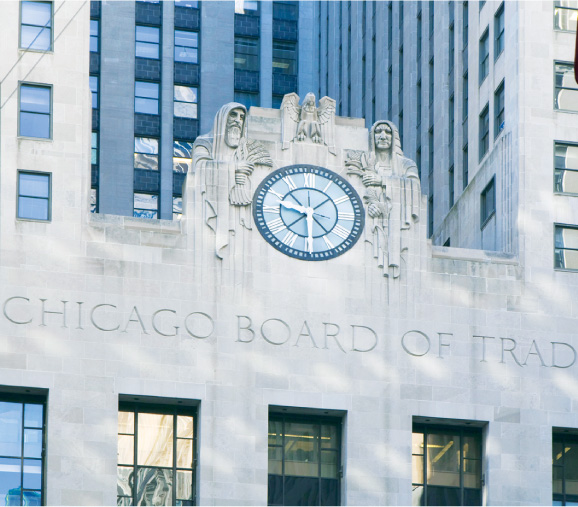The Chicago Board of Trade
Around the world, commodities are bought and sold on “exchanges,” markets organized in a specific location, where buyers and sellers meet to trade. But it wasn’t always like this.

The first modern commodity exchange was the Chicago Board of Trade, founded in 1848. At the time, the United States was already a major wheat producer. And St. Louis, not Chicago, was the leading city of the American West and the dominant location for wheat trading. But the St. Louis wheat market suffered from a major flaw: there was no central marketplace, no specific location where everyone met to buy and sell wheat. Instead, sellers would sell their grain from various warehouses or from stacked sacks of grain on the river levee. Buyers would wander around town, looking for the best price.
In Chicago, however, sellers had a better idea. The Chicago Board of Trade, an association of the city’s leading grain dealers, created a much more efficient method for trading wheat. There, traders gathered in one place—
This system meant that buyers could very quickly find sellers and vice-
The Chicago Board of Trade went on to become the world’s most important trading center for wheat and many other agricultural commodities, a distinction it retains to this day. And the Board’s rise helped the rise of Chicago, too. The city, as Carl Sandburg put it in his famous poem, “Chicago,” became:
Hog Butcher for the World,
Tool Maker, Stacker of Wheat,
Player with Railroads and the Nation’s Freight Handler;
Stormy, husky, brawling,
City of the Big Shoulders
By 1890, Chicago had more than a million people, second only to New York and far out-
Questions for Thought
Question
1. In Module 6 we mention how prices can vary in a tourist trap. Which market, St. Louis or Chicago, was more likely to behave like a tourist trap? Explain.
Question
2. What was the advantage to buyers from buying their wheat in the Chicago pit instead of in St. Louis? What was the advantage to sellers?
Question
3. Based on what you have learned from this case, explain why the online auction site eBay is like the Chicago pit. Why has it been so successful as a marketplace for second-